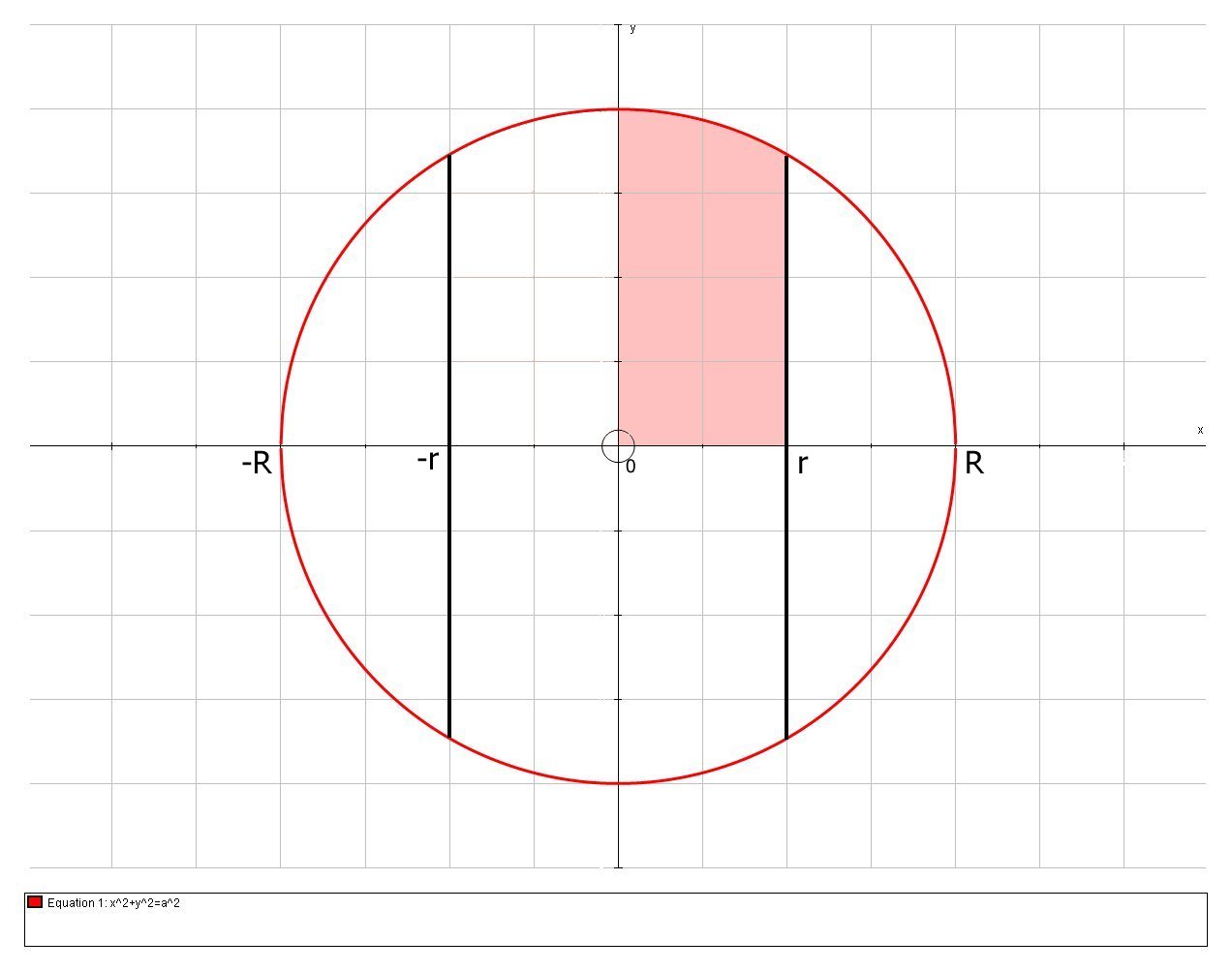A hole of radius r is bored through the center of a sphere of radius R. find the volume of the remaining portion of the sphere?
1 Answer
# (4pi)/3 (R^2-r^2)^(3/2) #
Explanation:
We basically are being asked to calculate the volume of a spherical bead, that is, a sphere with a hole drilled through it.
Consider a cross section through the sphere, which we have centred on the origin of a Cartesian coordinate system, and assuming

The red circle has radius
# x^2+y^2=R^2 #
Method 1 - Calculate core and subtract from Sphere
First let us consider the volume of the entire Sphere, which has radius
# :. V_("sphere") = 4/3 pi R^3 #
For the bore we can consider a solid of revolution. (Note this is not a cylinder as it has a curved top and bottom from the sphere). We will use the method of cylindrical shells and rotate about
# V = 2pi \ int_(alpha)^(beta) \ xf(x) \ dx #
Also note that we require twice the volume because we have a symmetrical portion above and below the
# V_("bore") = 2 * 2pi \ int_(0)^(r) \ xsqrt(R^2-x^2) \ dx #
We can evaluate using a substitution:
Let
#u=R^2-x^2 => (du)/dx = -2x#
When# { (x=0), (x=r) :} => { (u=R^2), (u=R^2-r^2) :}#
And so:
# V_("bore") = 4pi \ int_(R^2)^(R^2-r^2) \ (-1/2)sqrt(u) \ du #
# " " = 2pi \ int_(R^2-r^2)^(R^2) \ sqrt(u) \ du #
# " " = 2pi \ [ u^(3/2)/(3/2) ] _(R^2-r^2)^(R^2) #
# " " = (4pi)/3 \ [ u^(3/2) ] _(R^2-r^2)^(R^2) #
# " " = (4pi)/3 \ ((R^2)^(3/2) - (R^2-r^2)^(3/2)) #
# " " = (4pi)/3 \ (R^3 - (R^2-r^2)^(3/2)) #
# " " = (4pi)/3 R^3 - (4pi)/3 (R^2-r^2)^(3/2) #
And so the total volume is given by:
# V_("total") = V_("sphere") - V_("bore" #
# " " = 4/3 pi R^3 - ( (4pi)/3 R^3 - (4pi)/3 (R^2-r^2)^(3/2))#
# " " = (4pi)/3 (R^2-r^2)^(3/2) #
Method 2 - Calculate volume of bead directly
We can use the same method of a solid of revolution using the method of cylindrical shells and rotate about
# V_("total") = 2 * 2pi \ int_(r)^(R) \ x \ sqrt(R^2-x^2) \ dx #
We can evaluate using a substitution:
Let
#u=R^2-x^2 => (du)/dx = -2x#
When# { (x=r), (x=R) :} => { (u=R^2-r^2), (u=0) :}#
And so:
# V_("total") = 4pi \ int_(R^2-r^2)^(0) \ (-1/2) sqrt(u) \ du #
# " " = 8pi \ int_(0)^(R^2-r^2) \sqrt(u) \ du #
# " " = 8pi \ [ u^(3/2)/(3/2) ] _(0)^(R^2-r^2) #
# " " = (4pi)/3 \ [ u^(3/2) ] _(0)^(R^2-r^2) #
# " " = (4pi)/3 \ ((R^2-r^2)^(3/2) - 0) #
# " " = (4pi)/3 \ (R^2-r^2)^(3/2) # , as above

